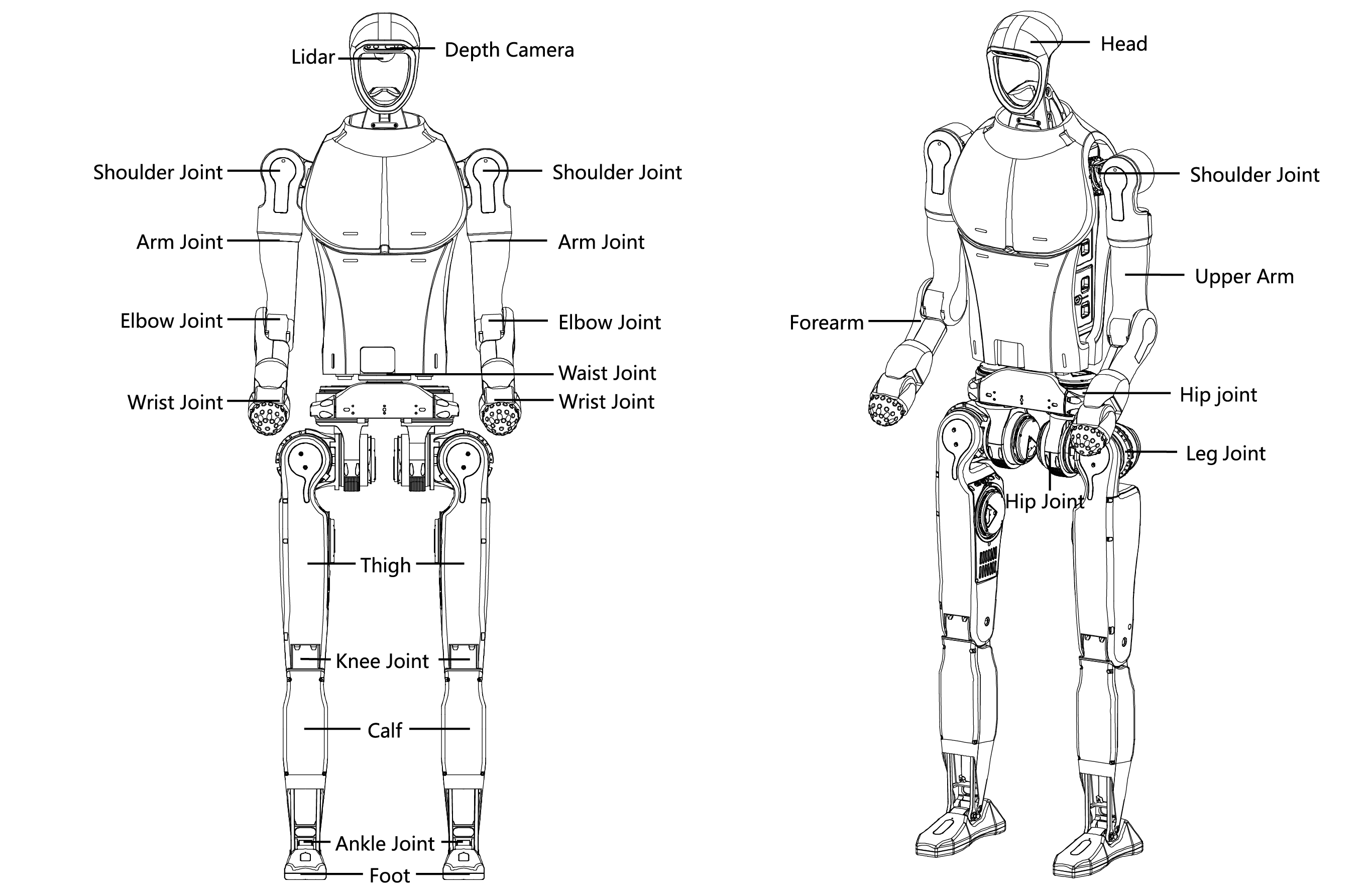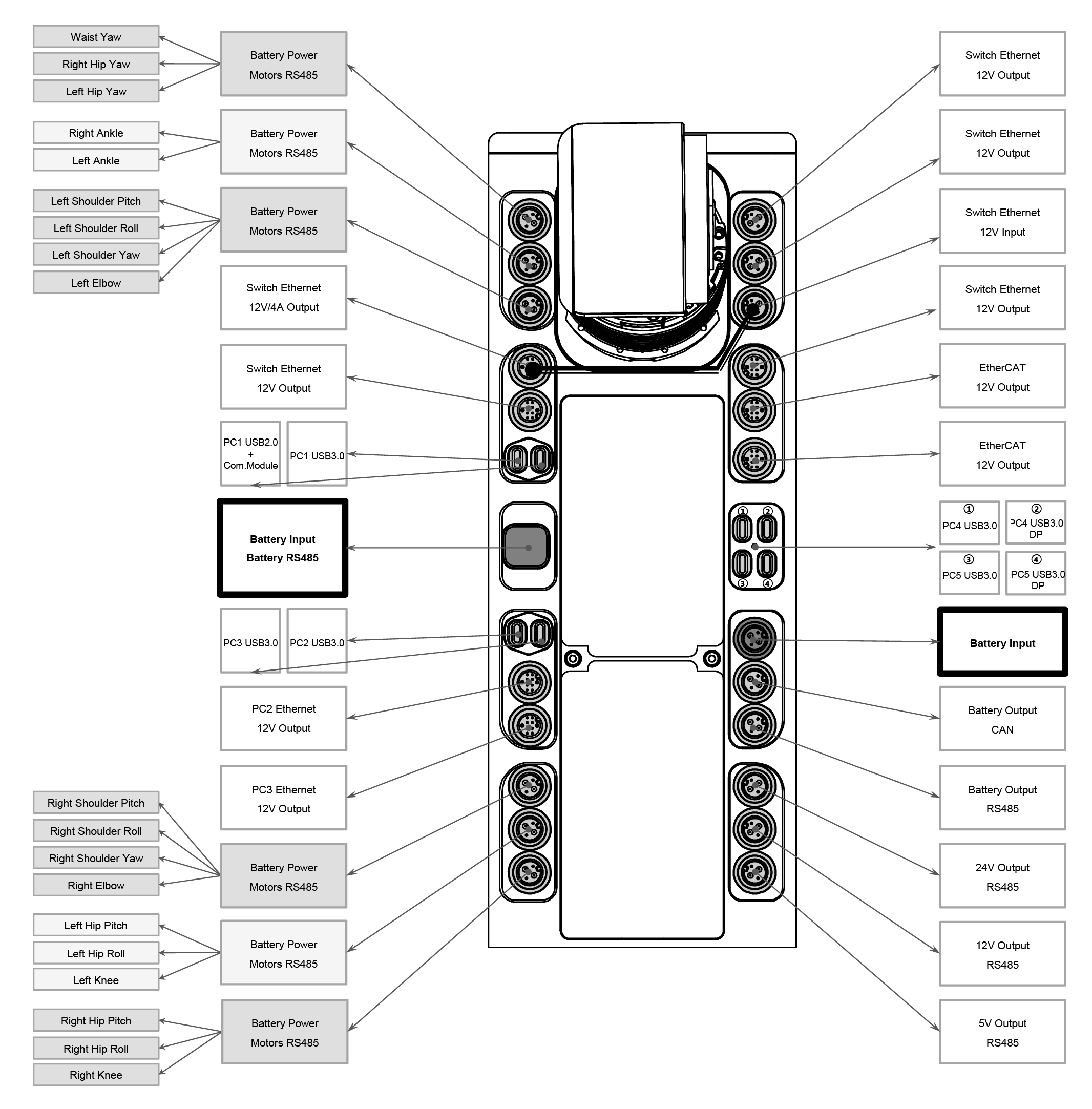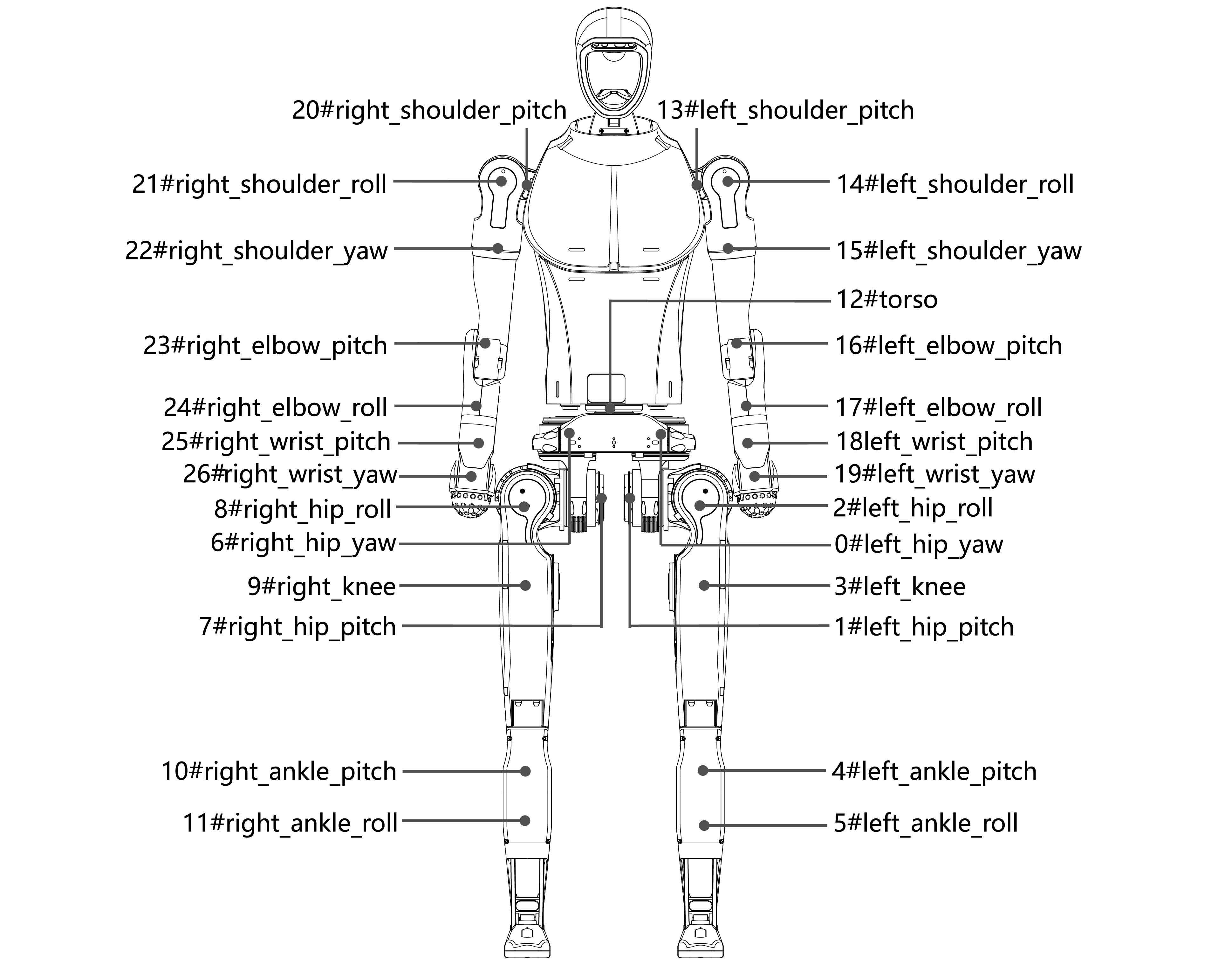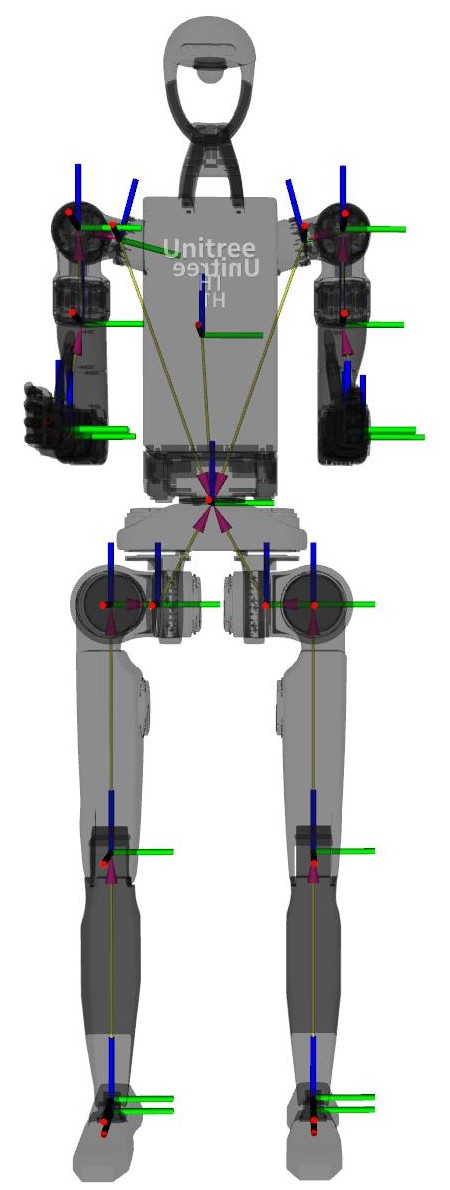H1-2 Overview
Component Overview
The H1-2 model is an advanced iteration of the H1, featuring improved motion capabilities and an expanded range of movement. Each arm is equipped with 7 degrees of freedom, each leg with 6, and the waist with 1 degree of freedom, resulting in a total of 27 degrees of freedom throughout the robot. With 27 joint motors, this configuration allows for highly precise control of motion and posture adjustment.

Electrical Interfaces
The H1-2 robot incorporates electrical interfaces positioned on its right side. These interfaces facilitate the connection of body joint motors, sensor peripherals, Ethernet ports, and other components. This design enhances convenience during debugging, issue troubleshooting, and secondary development processes.

On-board Computers
The H1-2 robot is equipped with one “Motion Control Computing Unit” and one “Development Computing Unit,” with an option to configure an additional expansion unit.
Component |
Motion Control Computing Unit (PC 1) |
Development Computing Unit (PC 2, PC 3) |
|---|---|---|
Model |
i5-1235U |
i7-1255U / i7-1265U |
Number of Cores |
10 |
10 |
Number of Threads |
12 |
12 |
Max Turbo Frequency |
4.40 GHz |
4.70 GHz & 4.80 GHz |
Memory |
8GB |
16GB & 32GB |
Memory Type |
LPDDR5 5200 MT/s (dual-channel) |
LPDDR5 5200 MT/s (dual-channel) |
Cache |
12 MB Intel® Smart Cache |
12 MB Intel® Smart Cache |
Storage |
500GB or more |
500GB or more |
Intel® Graphics Processing Unit |
None |
6.0 |
GPU |
Intel® Iris® Xe Graphics eligible |
Intel® Iris® Xe Graphics eligible |
Max Dynamic Frequency of GPU |
1.20 GHz |
1.20 GHz |
Gauss and Neural Accelerator |
3.0 |
3.0 |
Intel® Deep Learning Boost |
Yes |
Yes |
Intel® Adaptix™ Technology |
Yes |
Yes |
Intel® Hyper-Threading Technology |
Yes |
Yes |
Instruction Set |
64-bit |
64-bit |
OpenGL |
4.6 |
4.6 |
OpenCL |
3.0 |
3.0 |
DirectX |
12.1 |
12.1 |
IP Address |
Unaccessible |
192.168.123.162, 192.168.123.163 |
Attention
The “Motion Control Computing Unit” is exclusively reserved for Unitree motion control programs and is not accessible for external use. Developers are limited to utilizing the “Development Computing Unit” for secondary development. For the initial username and password, please contact our technical support team.
In the table above, the PC3 “Development Computing Unit” is an optional configuration, with its IP address set to 192.168.123.163.
The CPU module may be upgraded to a more advanced version, provided that the performance meets or exceeds the specifications listed.
Lidar
The H1-2 robot’s head is equipped with the MID-360 Lidar (IP: 192.168.123.120), providing exceptional environmental perception capabilities. Utilizing omnidirectional, full-angle scanning technology, the lidar captures real-time and precise environmental data. It enables the robot to efficiently detect and measure surrounding objects while delivering high-resolution point cloud data for enhanced operational accuracy.
Depth Camera
The H1-2 robot’s head also features the D435 depth camera, which offers superior visual perception capabilities. This camera enhances the robot’s ability to perceive and understand its environment accurately, facilitating precise spatial awareness and obstacle detection. These features allow the robot to intelligently interact with its surroundings and adapt flexibly to diverse scenarios.
M107 Joint Motor
The H1-2 robot integrates the self-developed M107 joint motor by Unitree, renowned for its exceptional performance and features. The motor delivers a maximum torque of 360 N·m and a maximum tension of 10,000 N under equivalent conditions with a 3.5 cm force arm. Designed with a hollow axle, the motor achieves a lightweight and compact structure. Additionally, it includes dual encoders for precise position and velocity feedback, meeting the demands of high-precision control applications.
Joint Numbering and Joint Limits
The joint numbering and corresponding limits for the H1-2 robot are as follows:
Joint Number |
Joint Name |
Limits (radians) |
|---|---|---|
20 |
right_shoulder_pitch |
-1.57 ~ +3.14 |
21 |
right_shoulder_roll |
-3.4 ~ +0.38 |
22 |
right_shoulder_yaw |
-2.66 ~ +3.01 |
23 |
right_elbow_pitch |
-1.6 ~ +2.53 |
24 |
right_elbow_roll |
-2.967 ~ +2.967 |
25 |
right_wrist_pitch |
-0.471 ~ +0.349 |
26 |
right_wrist_yaw |
-1.012 ~ +1.012 |
13 |
left_shoulder_pitch |
-3.14 ~ +1.57 |
14 |
left_shoulder_roll |
-0.38 ~ +3.4 |
15 |
left_shoulder_yaw |
-3.01 ~ +2.66 |
16 |
left_elbow_pitch |
-2.53 ~ +1.6 |
17 |
left_elbow_roll |
-2.967 ~ +2.967 |
18 |
left_wrist_pitch |
-0.471 ~ +0.349 |
19 |
left_wrist_yaw |
-1.012 ~ +1.012 |
12 |
torso |
-3.14 ~ +1.57 |
6 |
right_hip_yaw |
-0.43 ~ +0.43 |
7 |
right_hip_pitch |
-3.14 ~ +2.5 |
8 |
right_hip_roll |
-3.14 ~ +0.43 |
9 |
right_knee |
-0.26 ~ +2.05 |
10 |
right_ankle_pitch |
-0.897334 ~ +0.523598 |
11 |
right_ankle_roll |
-0.261799 ~ +0.261799 |
0 |
left_hip_yaw |
-0.43 ~ +0.43 |
1 |
left_hip_pitch |
-3.14 ~ +2.5 |
2 |
left_hip_roll |
-0.43 ~ +3.14 |
3 |
left_knee |
-0.26 ~ +2.05 |
4 |
left_ankle_pitch |
-0.897334 ~ +0.523598 |
5 |
left_ankle_roll |
-0.261799 ~ +0.261799 |
The image below displays the Unitree H1-2 humanoid robot with all joints labeled. It serves as a visual reference, correlating the joint numbers and names listed in the table to their positions on the robot.

Reference Frame, Joint Axes, and Zero Position
In the zero-degree configuration of all joints, the coordinate system is depicted as shown in the figure below. The x-axis is represented by the red line, the y-axis by the green line, and the z-axis by the blue line.
